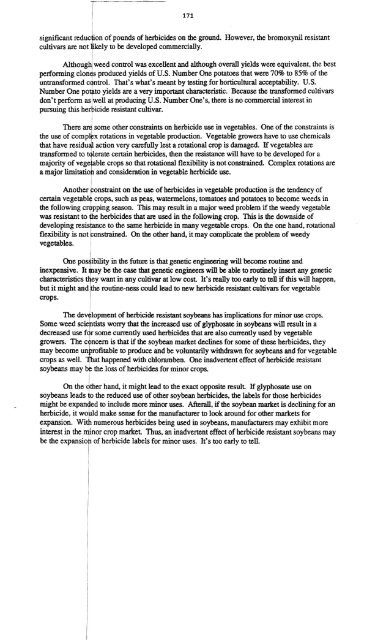Vol. 51â1997 - NorthEastern Weed Science Society
Vol. 51â1997 - NorthEastern Weed Science Society
Vol. 51â1997 - NorthEastern Weed Science Society
You also want an ePaper? Increase the reach of your titles
YUMPU automatically turns print PDFs into web optimized ePapers that Google loves.
171<br />
significant reduct:<br />
cultivars are not'<br />
of pounds of herbicides on the ground. However, the bromoxynilresistant<br />
ly to be developedcommercially.<br />
Althoughlweed control was excellent and althoughoverallyields were equivalent, the best<br />
performing clon~s produced yields of U.S. Number One potatoes that were 70% to 85% of the<br />
untransformed control. That's what's meant by testingfor horticulturalacceptability. U.S.<br />
Number One poX'to yields are a very important characteristic. Because the transformedcultivars<br />
don't perform as well at producingU.S. Number One's, there is no commercialinterest in<br />
pursuing this her icide resistantcultivar.<br />
I,<br />
There3' some other constraints on herbicide use in vegetables. One of the constraintsis<br />
the use of compl x rotations in vegetable production. Vegetablegrowers have to use chemicals<br />
that have residu action very carefully lest a rotationalcrop is damaged. If vegetablesare<br />
transformed to tt'lerate certain herbicides, then the resistancewill have to be developedfor a<br />
majority of vege ble crops so that rotational flexibilityis not constrained. Complex rotationsare<br />
a major limitatio and considerationin vegetableherbicideuse.<br />
Another fonstraint on the use of herbicidesin vegetableproductionis the tendencyof<br />
certain vegetable crops, such as peas, watermelons. tomatoes and potatoes to become weeds in<br />
the following cropping season. This may result in a major weed problemif the weedy vegetable<br />
was resistant to E' e herbicides that are used in the followingcrop. This is the downsideof<br />
developing resis ce to the same herbicidein many vegetablecrops. On the one hand, rotational<br />
flexibility is not, onstrained. On the other hand, it may complicatethe problemof weedy<br />
vegetables. i<br />
One possibility in the future is that genetic engineeringwill becomeroutine and<br />
inexpensive. It JIOaybe the case that genetic engineers will be able to routinelyinsert any genetic<br />
characteristics ~ey want in any cultivar at low cost It's really too early to tell if this will happen,<br />
but it might andIthe routine-ness could lead to new herbicideresistantcultivars for vegetable<br />
crops. ,<br />
The developmentof herbicideresistantsoybeanshas implicationsfor minor use crops.<br />
Some weed scientists worry that the increased use of glyphosatein soybeanswill result in a<br />
decreased use fqr some currently used herbicides that are also currentlyused by vegetable<br />
growers. Thetcdncem is that if the soybean market declinesfor some of these herbicides, they<br />
may become un rofitable to produce and be voluntarilywithdrawnfor soybeans and for vegetable<br />
crops as well. . at happened with chloramben. One inadvertenteffect of herbicide resistant<br />
soybeans may be the loss of herbicidesfor minor crops.<br />
On the Jther hand, it might lead to the exact opposite result If glyphosate use on<br />
soybeans leads tothe reduced use of other soybean herbicides,the labels for those herbicides<br />
might be expan~ed to include more minor uses. Afterall, if the soybeanmarket is decliningfor an<br />
herbicide, it wo ld make sense for the manufacturer to look around for other markets for<br />
expansion. Wi. numerous herbicidesbeing used in soybeans.manufacturersmay exhibit more<br />
interest in the minorcrop market. Thus. an inadvertenteffect of herbicideresistantsoybeans may<br />
bethe eXPansiar of herbicide labels for minor uses. It's too early to tell.
















